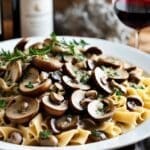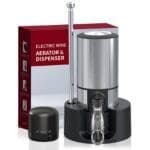This post may contain affiliate links. Please read my disclosure policy.
Riesling grape – The Zesty Rebel of the Wine World
Step aside, oenophiles, and make way for the zesty maestro, Riesling! With a pronunciation that rolls off the tongue as smoothly as the wine itself – ‘Rees-ling’ – this grape variety is a true virtuoso of versatility.
Known for its razor-sharp acidity and a flavour profile that can range from sweet to bone-dry, Riesling is like the life of the party – always ready to adapt to the mood and setting. It’s a grape that doesn’t just whisper its presence; it sings it from the rooftops!
Primary Flavours
Dive into a glass of Riesling and you’re in for a sensory fiesta. Imagine biting into a crisp, green apple, followed by a spritz of zesty lime, a spoonful of ripe peach, and a whiff of aromatic jasmine – that’s Riesling for you.
But it’s not all fruit and flowers; there’s often a distinctive minerality, reminiscent of wet stones after a rain. In warmer regions, Riesling might lean towards richer notes of apricot and nectarine, while in cooler areas, it keeps things sprightly with a lean, citrus-led ensemble.
Taste Profile
| Riesling | ||
|---|---|---|
| Aspect | Rating out of 5 | Characteristic |
| Sweetness | 🍷🍷🍷🍷🍷 | Can swing from dry wit to sweet charm, like a British sitcom |
| Body | 🍷🍷🍷 | Light to medium-bodied, as nimble as a dancer in a ballet |
| Tannins | As elusive as a sunbeam in London | |
| Acidity | 🍷🍷🍷🍷🍷🍷🍷 | Crisp and invigorating, like a brisk walk along the Thames |
| Alcohol by Volume | 🍷🍷🍷🍷 | Generally around 8-12%, as gentle as a Sunday morning in the countryside |
| Each wine glass icon 🍷 represents one point on a 10-point scale. Riesling, with its chameleon-like nature, offers a spectrum of flavors from zesty lime to ripe peach, often with a floral touch. It's a grape that surprises and delights, adaptable to a variety of dishes and occasions, much like a well-tailored suit. Whether it's a dry or sweet Riesling, each bottle tells its own unique story. |
Riesling Growing Regions
Riesling has its roots deeply planted in the German soil, but its vines have stretched across the globe, from the steep slopes of the Mosel valley to the sun-kissed hills of Australia’s Clare and Eden Valleys. In each locale, Riesling embraces the local terroir, reflecting the character of its homeland in every sip.
Origin
The tale of Riesling is steeped in German history, dating back to the 1400s. It’s a grape that’s seen the ebb and flow of winemaking fortunes, from the heights of royal favor to the lows of being overshadowed by trendier varieties. But like a true artist, Riesling has stood the test of time, now enjoying a well-deserved renaissance among wine enthusiasts.
Riesling Serving Temperature
To fully appreciate the symphony of flavours in a Riesling, serve it chilled but not ice-cold – around 9°C (48°F) is ideal. This temperature strikes the perfect chord, allowing the wine’s array of aromas and flavours to emerge without being muted by the cold.
Recommended Glass Type
Reach for a tall, slender glass to serve your Riesling. This type of glassware, often called a ‘flute’, allows the delightful aromatics to concentrate at the top, greeting your nose with each sip and enhancing the overall tasting experience.
Decanting Duration
Riesling usually doesn’t need decanting. It’s more of a ‘pop and pour’ star, ready to perform as soon as the cork is out. However, for aged or particularly complex bottles, a brief decant can help them shine by softening any sharp edges.
Wine Ageing: Drink Now or Age?
One of Riesling’s secret weapons is its ageing potential. While many are delightful in their youthful zestiness, others can age gracefully for decades, developing complex honeyed and petrol notes that add depth and intrigue to the wine’s profile.
Suggested Food Pairings
The versatility of Riesling in food pairings is comparable to a skilled chef who excels in complementing a wide range of culinary styles. From dry to sweet, coupled with vibrant acidity, it makes an exceptional partner for a variety of dishes.
For the Spice Lovers:
- Curries: A slightly off-dry variant beautifully offsets the heat of spicy curries, whether it’s an aromatic Thai green curry or a robust Indian Rogan Josh.
- Szechuan Cuisine: The bold and fiery flavors of Szechuan dishes find a refreshing counterpart in the crisp, fruity notes of the wine.
Seafood Extravaganza:
- Sushi and Sashimi: A dry style, with its crisp acidity, complements the delicate flavors of raw fish exquisitely.
- Barramundi with Lemon Herb Butter: This Australian favorite, featuring succulent barramundi fish, is elevated by the citrus and herb notes in a zesty variant.
- Crab Cakes: The wine’s minerality and fruitiness offer a delightful contrast to the richness of crab cakes.
Meat Pairings:
- Roast Pork: A medium-dry style can highlight the sweetness in pork, especially with apple-based sauces or glazes.
- Smoked Sausages: Its sweetness and acidity cut through the smokiness and fattiness of sausages.
- Chicken Tikka: A slightly sweet variant complements the spices and smokiness of the chicken.
Vegetarian and Vegan Friendly:
- Spicy Lentil Dishes: The spice and heartiness of lentil-based dishes are balanced by the fruity and fresh character of the wine.
- Roasted Vegetables: A dry style works well with a variety of roasted vegetables like bell peppers, zucchini, and carrots.
- Vegetarian Sushi Rolls: The clean, light flavors of vegetarian sushi are a perfect match for a dry or off-dry style.
Cheese Pairings:
- Feta and Goat Cheeses: The tanginess of these cheeses is softened by the fruity sweetness of a medium-dry style.
- Gouda: Especially aged Gouda, which pairs beautifully with the rich, honeyed notes of an older vintage.
Desserts:
- Apple Strudel: The apple and cinnamon flavors in the strudel harmonize with the apple notes often found in this wine.
- Lemon Tart: A sweet style complements the tartness of the lemon while adding complexity.
Fusion and Experimental Dishes:
- Tacos with Mango Salsa: The sweetness of mango and the spice of tacos create a playful combination with a crisp variant.
- Spicy Korean Fried Chicken: Its sweetness and acidity help balance the heat and richness of the chicken.
When pairing this wine with food, the balance of sweetness and acidity in the wine and its interaction with the flavors of the dish should be considered. Whether it’s a spicy dish needing a soothing touch or a rich dish requiring a refreshing counterbalance, there’s a style that fits perfectly.
Celebrated Wine Labels
| Riesling | ||
|---|---|---|
| Country | Wine Label | Varietal Name & Style |
| Mosel, Germany | Egon Müller | Renowned for crafting age-worthy, exquisite wines that define the essence of Mosel Riesling. |
| Mosel, Germany | Dr. Loosen | Champions the depth and versatility of Riesling, embodying the rich heritage of Mosel. |
| Margaret River, Australia | Leeuwin Estate | A beacon of New World innovation, infusing Australian character into classic Riesling styles. |
| Clare Valley, Australia | Clare Wine Co. | Masters in producing vibrant and crisp wines, capturing the unique terroir of Clare Valley. |
| Finger Lakes, USA | Hermann J. Wiemer | At the forefront of Riesling evolution in the USA, seamlessly blending tradition with modernity. |
| Each of these wineries not only showcases the distinctiveness of their respective regions but also exemplifies the versatility and global appeal of Riesling. |
FAQ
Where does the name Riesling originate from?
The name “Riesling” is German, reflecting its origins and long history in Germany. The exact etymology is unclear, but it’s closely associated with the Rhine region.
To which wines is Riesling similar?
Riesling is similar to Chenin Blanc and Gewürztraminer, as they all can produce aromatic wines with a range of sweetness and high acidity. These varieties share a propensity for expressing terroir and complexity.
Which country produces the most Riesling?
Germany is the largest producer of Riesling, particularly in regions along the Rhine and Mosel rivers. However, it’s also widely grown in France’s Alsace region, Austria, Australia, and the United States.
What are some interesting facts about Riesling?
• Riesling is a white grape variety originating from Germany’s Rhine region.
• Renowned for its versatility, Riesling can range from bone-dry to lusciously sweet.
• It has a distinctive aroma, often described as fruity and floral, with a high acidity.
• Riesling wines are known for their ability to age gracefully, developing complex flavours over time.
Conclusion
In the grand concert hall of wines, this wine plays a solo that captivates and delights. Its ability to express the nuances of its terroir, combined with its wide range of styles, makes it a variety that’s both exhilarating and deeply satisfying. Whether you prefer it whispering gentle notes of citrus or belting out a bold, fruity melody, Riesling is a grape that deserves a standing ovation.
Sip smarter, subscribe now!
Subscribe for gourmet tips, event updates, travel ideas, and a free e-book on Food Pairings. Start your journey to culinary and travel excellence!















